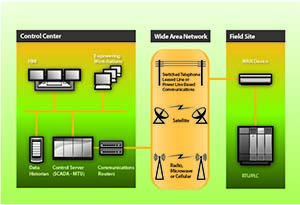 By Steve Sponseller, Kepware Technologies
By Steve Sponseller, Kepware Technologies
Automation in Drilling
Most of the general public is unaware that there is an automation revolution happening in the exploration and drilling segment of the Oil & Gas Industry. Like most automation endeavors, this revolution is being driven by the demand for improved efficiency, accurate reporting, and escalated safety requirements.
The fast-paced drilling taking place in current shale gas exploration and production sites requires improved process efficiency. Shale gas is a revolution in and of itself, with promises of lower energy costs and less carbon dioxide emissions than traditional hydrocarbon energy sources. Improved efficiency demands are a result of the wide geographic spread of shale plays and the need for multiple wells to drill and frack in order to tap into the gas that is trapped in the shale rock. Companies are also performing advanced analytics on their drilling operations, which allows them to predict conditions and events before they happen based on the outcomes of previous operations. Improvements in efficiencies have allowed companies to reduce drill time to two weeks for some wells, and to set drill time goals closer to 7 to 10 days for others.
FIG 1: Typical remote communications network and components.
The need for accurate reporting ranges from demands for corporate and industry analysis to the requirements established by government regulations. For example, the Environmental Protection Agency (EPA) is driving companies to provide accurate reporting. Missing data in these reports can result in hefty fines.
And finally, the Deepwater Horizon incident of 2010 has escalated safety concerns in both offshore and onshore drilling operations in which several different drilling contractors and service companies are operating simultaneously on a rig. Automation can provide the means to improve safety in these situations. According to the 2013 ARC Insights report “Wireless Strategies for Unconventional Reservoirs,” transportation to rigs is a major safety concern. In fact, the leading cause of death among rig workers happens while en route to a rig. While loss of life is obviously unfortunate, these types of incidents are very expensive as well. Companies are turning to automation as a way to reduce the amount of required traveling.
To satisfy these efficiency, reporting, and safety requirements, companies are now remotely collecting data and monitoring drilling operations 24/7. Corporate drilling centers are emerging that enable seasoned staff to keep a careful eye on each of the many concurrent operations that are going on at different sites in the field. This allows experts to ensure proper operations from a safety standpoint and to provide instant expert input when needed. These drilling centers allow them to remain “on the beach” and not have to travel to remote sites every time their experience is needed or an issue arises. Data is also continually being collected and stored to empirically develop analytical models that can be compared to the real-time scenarios of a current drilling operation.
Read the entire article on the Offshore Engineer web site.
